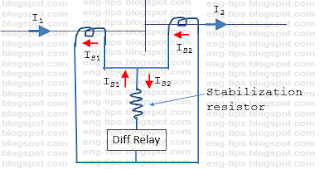Over
current protection and earth fault is simple protection. Being low cost
protection it is widely used across all levels. For lower voltage levels it is
main protection, and for higher voltage levels it is used as backup protection.
The reason being this protection does not have clear boundaries of protection.
Over current protection is for phase current and earth fault is for neutral current (residual current). The characteristics for both protections are same.
This
protection is of two types: definite time (DT) or inverse definite minimum time
(IDMT).
Definite
Time (DT): In this type, protection will start when current reaches a set
value, and protection will operate after a set time. For example, we for a
transformer having maximum through fault current of 100A we can set DT protection
110A with time delay 100ms. In this way protection will operate in case of
faults inside transformer only. For faults on downstream current will be less
than 100A and protection will not operate.
Inverse Definite Minimum Time (IDMT): In this type, protection will start when current reaches a set value, and operating time of protection will depend on the level of current. If current is very high compared to set value, protection will operate fast. If current is slightly high from set value, relay will take more time to operate. In this way, a curve can be drawn between current and time for each relay. There are standard curves for which relays are designed. User can select from these curves as per requirement. For mechanical relays these curves are fixed as per design. However, in case of static / numerical relay curve can be selected form settings of relay.
For example, we have set relay in IDMT standard inverse for a transformer. Full load current of the transformer is 100A, and we have set IDMT start at 120A. The relay will start when current increases beyond 120A. If the current is 1200A, which means 10 times of set value. For 10 times current, the operating time is 2s (from curve). There is another setting called Time multiplier setting (TMS), say it is set at 0.4 for this transformer. The operating time of relay will be 0.8s.
If fault current is 240A, which means double of set value. For double current the operating time is 10s. The operating time of relay will be 4s.
In this way, relay will operate in 800ms for fault current of 1200A and in 4 sec for fault current of 240A
The
operating time can be calculated as per below (IEC):
Standard inverse: t = TMS
x 0.14 / [(Ir^0.02) – 1]
Very inverse: t = TMS x 13.5
/ [Ir – 1]
Extremely inverse: t = TMS x 80 / [(Ir^2) – 1]





















